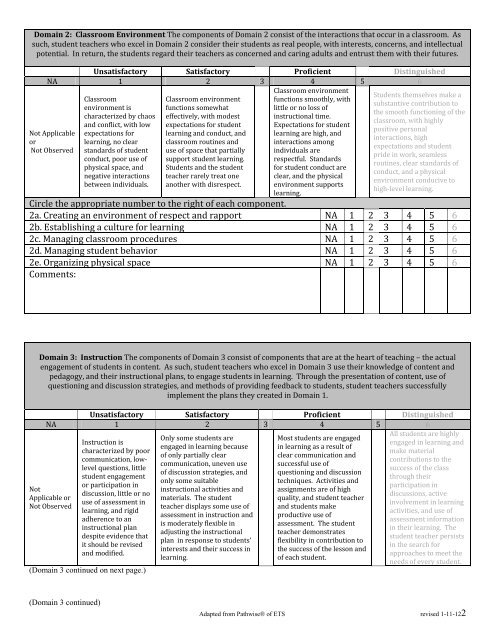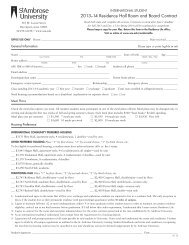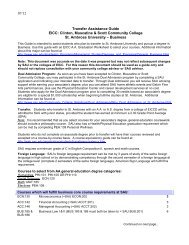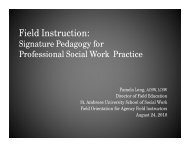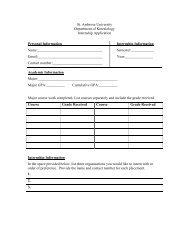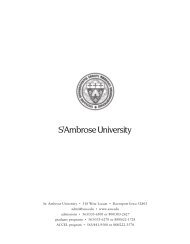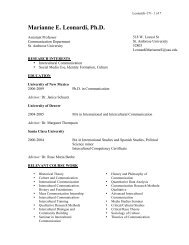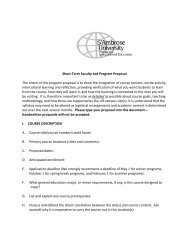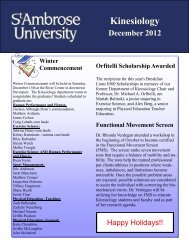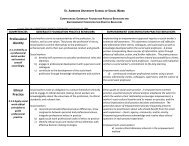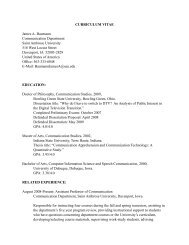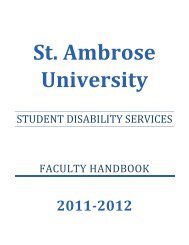Student Teacher Summative Evaluation & Assessment of ...
Student Teacher Summative Evaluation & Assessment of ...
Student Teacher Summative Evaluation & Assessment of ...
Create successful ePaper yourself
Turn your PDF publications into a flip-book with our unique Google optimized e-Paper software.
Domain 2: Classroom Environment The components <strong>of</strong> Domain 2 consist <strong>of</strong> the interactions that occur in a classroom. As<br />
such, student teachers who excel in Domain 2 consider their students as real people, with interests, concerns, and intellectual<br />
potential. In return, the students regard their teachers as concerned and caring adults and entrust them with their futures.<br />
Unsatisfactory Satisfactory Pr<strong>of</strong>icient Distinguished<br />
NA 1 2 3 4 5 6<br />
Classroom environment<br />
<strong>Student</strong>s themselves make a<br />
Classroom<br />
Classroom environment<br />
functions smoothly, with<br />
substantive contribution to<br />
environment is<br />
functions somewhat<br />
little or no loss <strong>of</strong><br />
the smooth functioning <strong>of</strong> the<br />
characterized by chaos effectively, with modest<br />
instructional time.<br />
classroom, with highly<br />
and conflict, with low expectations for student<br />
Expectations for student<br />
positive personal<br />
expectations for learning and conduct, and learning are high, and<br />
interactions, high<br />
learning, no clear classroom routines and<br />
interactions among<br />
expectations and student<br />
standards <strong>of</strong> student use <strong>of</strong> space that partially individuals are<br />
pride in work, seamless<br />
conduct, poor use <strong>of</strong> support student learning. respectful. Standards<br />
routines, clear standards <strong>of</strong><br />
physical space, and <strong>Student</strong>s and the student for student conduct are<br />
conduct, and a physical<br />
negative interactions teacher rarely treat one<br />
clear, and the physical<br />
environment conducive to<br />
between individuals. another with disrespect.<br />
environment supports<br />
high-level learning.<br />
learning.<br />
Not Applicable<br />
or<br />
Not Observed<br />
Circle the appropriate number to the right <strong>of</strong> each component.<br />
2a. Creating an environment <strong>of</strong> respect and rapport NA 1 2 3 4 5 6<br />
2b. Establishing a culture for learning NA 1 2 3 4 5 6<br />
2c. Managing classroom procedures NA 1 2 3 4 5 6<br />
2d. Managing student behavior NA 1 2 3 4 5 6<br />
2e. Organizing physical space NA 1 2 3 4 5 6<br />
Comments:<br />
Domain 3: Instruction The components <strong>of</strong> Domain 3 consist <strong>of</strong> components that are at the heart <strong>of</strong> teaching – the actual<br />
engagement <strong>of</strong> students in content. As such, student teachers who excel in Domain 3 use their knowledge <strong>of</strong> content and<br />
pedagogy, and their instructional plans, to engage students in learning. Through the presentation <strong>of</strong> content, use <strong>of</strong><br />
questioning and discussion strategies, and methods <strong>of</strong> providing feedback to students, student teachers successfully<br />
implement the plans they created in Domain 1.<br />
Unsatisfactory Satisfactory Pr<strong>of</strong>icient Distinguished<br />
NA 1 2 3 4 5 6<br />
All students are highly<br />
Only some students are<br />
Most students are engaged<br />
Instruction is<br />
engaged in learning and<br />
engaged in learning because in learning as a result <strong>of</strong><br />
characterized by poor<br />
make material<br />
<strong>of</strong> only partially clear<br />
clear communication and<br />
communication, lowlevel<br />
questions, little<br />
success <strong>of</strong> the class<br />
contributions to the<br />
communication, uneven use successful use <strong>of</strong><br />
<strong>of</strong> discussion strategies, and questioning and discussion<br />
student engagement<br />
through their<br />
only some suitable<br />
techniques. Activities and<br />
or participation in<br />
participation in<br />
Not<br />
instructional activities and<br />
assignments are <strong>of</strong> high<br />
discussion, little or no<br />
discussions, active<br />
Applicable or<br />
materials. The student<br />
quality, and student teacher<br />
use <strong>of</strong> assessment in<br />
involvement in learning<br />
Not Observed<br />
teacher displays some use <strong>of</strong> and students make<br />
learning, and rigid<br />
activities, and use <strong>of</strong><br />
assessment in instruction and productive use <strong>of</strong><br />
adherence to an<br />
assessment information<br />
is moderately flexible in<br />
assessment. The student<br />
instructional plan<br />
in their learning. The<br />
adjusting the instructional<br />
teacher demonstrates<br />
despite evidence that<br />
student teacher persists<br />
plan in response to students’ flexibility in contribution to<br />
it should be revised<br />
in the search for<br />
interests and their success in the success <strong>of</strong> the lesson and<br />
and modified.<br />
approaches to meet the<br />
learning.<br />
<strong>of</strong> each student.<br />
needs <strong>of</strong> every student.<br />
(Domain 3 continued on next page.)<br />
(Domain 3 continued)<br />
Adapted from Pathwise® <strong>of</strong> ETS revised 1-11-122


